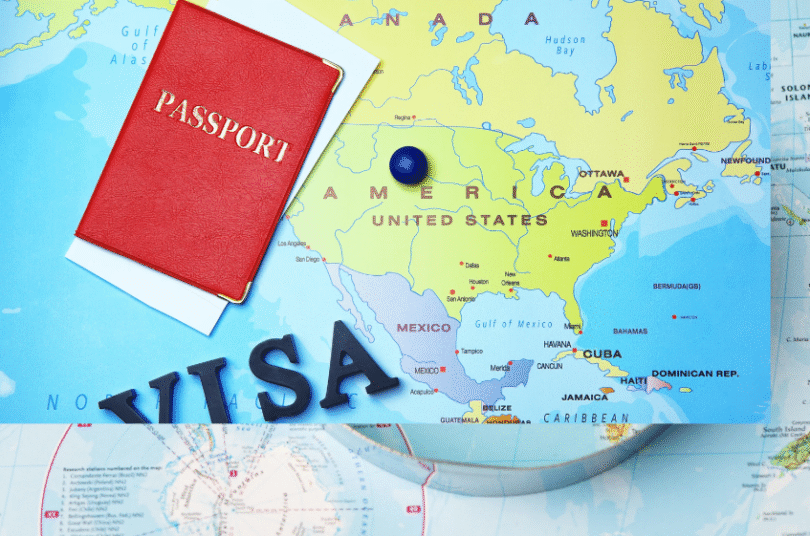So, you’ve made it to the U.S. as an international student on an F-1 visa. First of all congrats! That’s a big step. You’ve worked hard to get here, studied hard to succeed, and now you might be wondering, “How can I stay here and work after graduation?”
Well, I’m here to tell you that it is possible but it takes planning, preparation, and sometimes patience.
In this article, we’ll explain how the F-1 visa works, what a sponsored job really means, how to apply for Optional Practical Training (OPT), and how to secure a job that will sponsor your work visa.
Understanding the F-1 Student Visa
Before we talk about getting a job in the U.S., let’s first understand what your current visa—the F-1 student visa—actually allows you to do.
What is an F-1 Visa?
The F-1 visa is a non-immigrant visa given to international students who want to study in the United States. It allows you to attend schools, colleges, or universities that are approved by the U.S. government.
In simple terms: If you’re in the U.S. on an F-1 visa, your main job is to study.
What You Can Do on an F-1 Visa
While your main focus is education, there are a few things you’re allowed to do:
- Study full-time at your chosen school.
- Work part-time on campus (usually up to 20 hours per week).
- Apply for internships or off-campus work through programs like CPT (Curricular Practical Training) or OPT(Optional Practical Training), if approved.
- Travel in and out of the U.S. as long as your visa and passport are valid.
What You Cannot Do on an F-1 Visa
- You cannot work off-campus without approval.
- You cannot do full-time jobs unless it’s through OPT or CPT.
- You cannot stay in the U.S. permanently on this visa alone. It’s meant only for education.
Why This Matters
Understanding the limits of your F-1 visa is important because doing anything outside the rules can put your visa at risk. You must stay “in status”—which means following all the rules of your visa at all times.
Once your studies are over, the F-1 visa gives you 60 days to either:
- Leave the U.S.,
- Transfer to another school, or
- Change your visa status (for example, by moving to a work visa like the H-1B).
This is where your journey to a sponsored job begins.
What is a Sponsored Job in the US?
A sponsored job means that a company in the U.S. is willing to help you get a work visa so that you can stay and legally work in the country after your studies.
In most cases, the company will file a visa application on your behalf with the U.S. government. This process is called visa sponsorship.
They’re not giving you money, they’re giving you legal support to stay and work.
What Kind of Visa Can You Get Through Job Sponsorship?
The most common work visa international students move to after an F-1 visa is the:
- H-1B visa – This is a visa for skilled workers, and it’s often used by companies to hire international graduates for full-time jobs.
There are other visas too, like:
- O-1 visa – For people with special talents or extraordinary achievements.
- L-1 visa – For people who work for companies that have offices in both their home country and the U.S.
But for now, let’s focus on the H-1B, since it’s the one most international students apply for.
What is the H-1B Visa?
The H-1B visa allows U.S. companies to hire foreign workers in specialty fields like technology, engineering, science, finance, healthcare, and more.
To qualify:
- You must have at least a bachelor’s degree (which you likely earned on your F-1 visa).
- The job must require a degree in your field.
- The company must be willing to sponsor you by filing documents with U.S. immigration.
However, just because you have a degree and apply for a job doesn’t mean the company will sponsor you. Not all companies are willing to do it. Some avoid it because:
- It involves paperwork.
- It costs money (they must pay filing fees).
- The visa process can be slow and uncertain.
That’s why it’s important to look for companies that are open to hiring international graduates and have a history of sponsoring visas.
Don’t worry I’ll show you how to find those companies later in this article.
Steps to Move from F-1 to a Sponsored Job
Now that you understand your F-1 visa and what a sponsored job means, let’s get to see the full step-by-step process on how to make this big move.
Step 1: Apply for Optional Practical Training (OPT)
OPT is a special work permission for F-1 students. It allows you to work for up to 12 months in your field of study after you graduate.
If you studied a STEM course (like science, tech, engineering, or math), you can even apply for a 24-month extension which gives you a total of 3 years to work.
Why OPT is Important:
- It gives you time to work in the U.S. legally while you look for a company that will sponsor you.
- Many companies are more willing to hire international students if you already have work authorization (which OPT gives you).
When to Apply for OPT:
- You must apply 90 days before your program ends, or no later than 60 days after it ends.
- Talk to your school’s international student office. They’ll help with the paperwork.
Step 2: Find a Job Related to Your Degree
You must find a job closely related to what you studied.
For example:
- If you studied Computer Science, you can work as a software developer.
- If you studied Marketing, you can work in a marketing firm or department.
Tips to find a job:
- Use job platforms like LinkedIn, Indeed, or Handshake (if you’re still in school).
- Go to career fairs and networking events.
- Tell your professors or career center you’re job hunting—they often know employers.
Step 3: Start Working and Gain Experience
Once you get a job using OPT, work hard and learn fast. This is your chance to prove your value to the company.
During this time:
- Be professional and reliable.
- Ask questions, grow, and build good relationships at work.
- Let your employer know early that you will eventually need visa sponsorship to stay in the U.S.
Step 4: Ask for H-1B Sponsorship
When you’ve built trust at work, it’s time to ask your employer to sponsor you for an H-1B visa.
When to bring it up:
- It’s best to talk to your manager or HR at least 6–7 months before your OPT ends.
- The H-1B process usually starts in March, with results known by April–May. If selected, the H-1B status begins in October.
What the company has to do:
- File an application with U.S. Citizenship and Immigration Services (USCIS).
- Submit documents that prove you’re qualified.
- Pay some government filing fees.
Step 5: Enter the H-1B Lottery
Here’s the tricky part: The H-1B visa has a lottery system.
Every year, only 85,000 visas are given out:
- 65,000 for people with a bachelor’s degree.
- 20,000 extra for people with a U.S. master’s degree.
That means not everyone who applies gets selected. But if you do, your H-1B begins in October of that same year.
If you’re not picked, you can:
- Keep working if you have time left on OPT.
- Try again the next year.
- Look for other visa options (we’ll talk about that soon).
Tips for Finding Companies That Sponsor International Students
Finding the right job is important but finding one that’s ready to sponsor your visa is even more important. Here are smart and practical ways to find such companies:
1. Target Companies That Have Sponsored Before
Some companies already have a history of hiring international students. They know how the process works and are usually open to doing it again.
How to find them:
- Use websites like myvisajobs.com. It shows a list of companies that sponsored H-1B visas in the past.
- Search company names on LinkedIn and add “H-1B” to see if they’ve sponsored before.
- Ask your school’s career center or international office, they often have this data.
2. Focus on Industries That Commonly Sponsor
Some industries are more likely to offer sponsorship than others. These include:
- Technology and Software
- Finance and Accounting
- Engineering
- Healthcare and Pharmaceuticals
- Higher Education and Research
Start by applying to companies in these fields. You’ll increase your chances of finding a sponsor.
3. Use the Right Keywords When Job Hunting
When applying online, include keywords like:
- “H-1B sponsorship available”
- “Willing to sponsor F-1 OPT/CPT”
- “Will sponsor work visa”
This can help you filter out jobs that are open to international applicants.
4. Be Honest About Your Status
Always be honest in your resume or during interviews. Don’t hide the fact that you’re on OPT or that you’ll need sponsorship in the future.
Some students try to delay this conversation but it’s better to be upfront so that both sides are clear from the start.
5. Use Campus Resources
Your school is a great place to start your job search:
- Attend job fairs organized by your university.
- Ask professors or teaching assistants if they know hiring companies.
- Join student organizations that focus on career development.
Some universities even have employer partnerships that support visa sponsorships!
6. Network, Network, Network
You’ve probably heard it before, but it works: “It’s not just what you know—it’s who you know.”
Ways to network:
- Attend professional meetups, tech talks, or industry events.
- Join LinkedIn groups for international students or professionals in your field.
- Reach out politely to alumni from your school who are working in the U.S.
Even one connection can lead to your dream job.
Other Visa Options If H-1B Doesn’t Work Out
So, what if you’re not selected in the H-1B lottery or your employer cannot sponsor you? Don’t worry, you still have options. Here are a few alternative visa paths you can explore:
1. STEM OPT Extension (For STEM Majors Only)
If you studied a STEM course—like engineering, computer science, mathematics, or biology—you can apply for a 24-month extension on top of your original 12-month OPT.
That gives you up to 3 years of work authorization. This gives you more time to:
- Gain experience
- Apply for H-1B again
- Find an employer willing to sponsor you
Important: You must apply before your initial 12-month OPT ends.
2. Cap-Exempt H-1B Jobs
Some jobs don’t follow the regular H-1B lottery and can sponsor anytime during the year. These are called cap-exempt organizations.
They include:
- Universities and colleges
- Non-profit research organizations
- Government research institutions
If you work for these places, they can file an H-1B for you any time of the year, and you don’t have to worry about the lottery.
3. O-1 Visa (For Individuals with Exceptional Skills)
This visa is for people with extraordinary ability in their field—like tech, science, art, education, business, or athletics.
You’ll need to prove:
- You’ve won awards
- You’ve published work
- You’ve made major contributions in your field
It’s harder to get, but if you’re very skilled and can show strong evidence, it’s a great alternative.
4. L-1 Visa (For Intra-Company Transfers)
If your employer has offices in both the U.S. and your home country, you may be eligible for an L-1 visa.
Here’s how it works:
- You leave the U.S. and work for the same company in your home country for 1 year.
- Then the company transfers you back to the U.S. under an L-1 visa.
This option requires planning, but it’s legal and effective.
5. Marriage to a U.S. Citizen
This may not apply to everyone, but it’s worth mentioning. If you marry a U.S. citizen, you may be eligible for a green card.
This doesn’t mean you should marry just to stay in the U.S.—immigration takes marriage fraud very seriously. But if you’re in a genuine relationship, this path is an option.
6. Study More (Master’s or PhD)
If you want to stay longer in the U.S., going back to school is a legal way to extend your stay and improve your qualifications.
- A U.S. master’s degree gives you an extra chance in the H-1B lottery.
- PhD programs also come with more respect in the job market.
Plus, you can apply for OPT again after completing your new program.
These visa alternatives can give you more time or even a different path to stay in the U.S. legally and continue working toward your goals.
Common Mistakes to Avoid During the Transition
Transitioning from an F-1 visa to a sponsored job in the U.S. can be a smooth process—but many students make small mistakes that create big problems. Let’s talk about the most common ones, so you can avoid them completely.
1. Waiting Too Long to Apply for OPT
Some students wait until the last minute to apply for OPT. But remember:
- There’s a processing time of up to 90 days.
- If you miss the application window, you may lose your chance to work.
What to do instead:
Apply for OPT as early as possible, up to 90 days before your graduation date.
2. Working Without Authorization
It’s illegal to work in the U.S. without the right work permit. Some students:
- Start working before their OPT is approved.
- Continue working after their OPT expires.
This is risky. It could affect your future visa or green card application. Wait for your EAD card (OPT approval) before starting any job. Keep track of your end date.
3. Not Keeping Records
Many students don’t keep copies of important documents like:
- I-20 forms
- Job offer letters
- Pay stubs
- OPT approvals
You’ll need these later for visa applications or H-1B filing. Create a digital folder and save all documents safely (Google Drive or Dropbox works great).
4. Not Talking to Your Employer About Sponsorship
Some students are too shy or scared to talk to their company about sponsorship. They wait too long, and by the time they bring it up, it’s too late for the H-1B deadline. You should have the conversation early. Let them know politely and professionally that you’ll eventually need sponsorship.
5. Relying Only on One H-1B Lottery Attempt
The H-1B lottery is random, and not everyone gets picked. Some students assume they’ll get it on the first try and don’t make a backup plan.
What you should do:
- Always have a Plan B (like STEM OPT extension, cap-exempt jobs, or further studies).
- Don’t wait until your OPT expires before thinking ahead.
6. Choosing the Wrong Job or Employer
If your job doesn’t match your field of study, you could get in trouble with USCIS.
For example:
- If you studied biology and take a job in fashion sales, that could be seen as a violation of your visa.
7. Not Keeping SEVIS Updated
You must update your SEVIS record if you:
- Change your address
- Change jobs
- Start a new program
If you don’t update it, your F-1 status could be at risk.
You can use your school’s international office to help update these records correctly and on time.
Frequently Asked Questions (FAQs)
1. Can I work in the U.S. immediately after graduation on an F-1 visa?
You can work in the U.S. after graduation if you’ve applied for and received OPT.
2. What is the difference between OPT and H-1B?
OPT is temporary (up to 3 years for STEM), while H-1B is a long-term visa sponsored by your employer.
3. When should I tell my employer I need sponsorship?
It’s best to discuss sponsorship during or right after receiving the job offer.
4. What happens if I don’t get selected in the H-1B lottery?
You can try again next year, use your STEM OPT extension, or explore other visa options.
5. Can any U.S. company sponsor an H-1B visa?
Yes, but it’s easier with companies that have experience sponsoring visas.
6. Can I switch jobs after I get my H-1B visa?
Yes, but your new employer will need to file a new H-1B petition.
7. How do I know if my job offer qualifies for H-1B?
Your job must require a bachelor’s degree and be in a specialty occupation related to your field.
8. What if I lose my job while on OPT or H-1B?
You can stay up to 90 days on OPT and 60 days on H-1B to find a new job.
Conclusion
Transitioning from an F-1 student visa to a sponsored job in the U.S. may seem like a complex process, but with the right preparation and knowledge, it’s absolutely achievable. When you start early, understand your visa options, and remain proactive in securing sponsorship, you can smoothly navigate this journey toward building your career in the U.S.
With patience and the right guidance, you’ll be on your way to securing a sponsored job and achieving your U.S. career goals. Best of luck in your journey. Stay persistent and continue to explore all the opportunities available!






